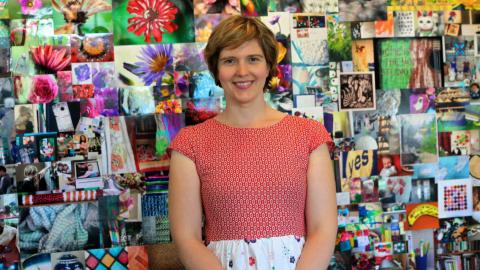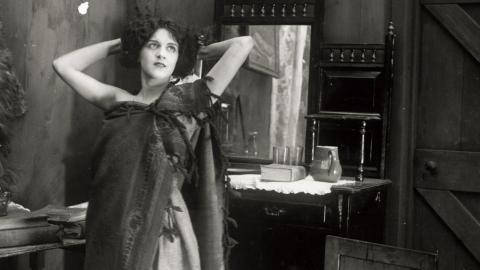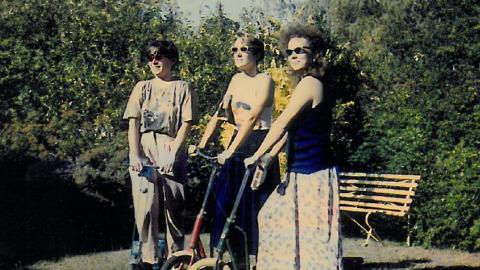

Staff Profile: Jennifer Gall
‘A curator has to think ahead 100 years to anticipate the needs of researchers in the future’ – Jennifer Gall.
When did music become your passion?

Jennifer Gall: I grew up on the North Coast of NSW, first in Casino, where I learned three important life-skills: how to swim; how to ride a bike; and how to rapidly adjust my posture to avoid being prodded hard between the shoulder blades by the ballet teacher. Lismore in New South Wales was where the world of music opened up to me thanks to a dedicated band of nuns at St Marys and, later, through the Lismore (Northern Rivers) Conservatorium’s inspiring orchestral collaborations with the Queensland Symphony Orchestra. While I was studying at the University of New England in Armidale I also discovered an unexpected bonus: the vibrant Armidale folk-music scene. I began playing in bands at functions in tiny rural halls where the clientele were either farming people, who were expert dancers, or drunken university students, who were expert at flinging each other across the room. After ending up with a joint honours degree in History and English I undertook a doctorate in music at the Australian National University (ANU) School of Music in Canberra, to uncover the role of women in the Australian music made at home from the time of white settlement up to the present.
Do you have a favourite musical instrument?
I play the violin, viola, guitar, piano and harp. I can’t say I really have one favourite. I do have an 1840s square piano that I am very fond of.

Square pianos aren’t really square, they are rectangular with horizontal strings arranged diagonally across the case, the keyboard set in the long side and the sounding board in the short side.
Each instrument I play has its own voice and mood so they lend themselves to very different forms of expression. It’s more a matter how I feel at the time. Since I enjoy a wide range of musical genres, from classical to folk, being able to play a number of instruments allows me to perform a number of different styles of music.
What kind of jobs did you have before joining the NFSA?
My first job after leaving university was to carry out preservation work on, and curate an exhibition of, items in the Young Maritime Collection for an in-house exhibition at the Department of Transport. Next, I wrote a history of Sydney Airport for the Department of Aviation. There were many extraordinary stories – such as those told by Tommy Young, a test pilot for Beauford Bombers at Sydney Airport during the Second World War. He had been a pilot with New England Airways during the 1930s, when he used to navigate landing at the airport in poor visibility by waiting for the smell of the tannery to indicate that he was where he ought to be in relation to the runway!
I had an interlude designing, researching and helping create the Bicentennial Heritage trail around Lake Burley Griffin and then won the job of Assistant Manager of Oral History at the National Library of Australia. Throughout my years at ANU studying and after completing the doctorate, I worked for Professor Larry Sitsky as Research Officer on the Australian Research Council project: The role of the piano in Australian Cultural History. I joined the NFSA in 2010 as Assistant Manager of Research Programs. The team administered the Scholars and Artist in Residence program, the internship program, staff fellowships and the Indigenous fellowship.
What’s your role at the NFSA now?
In 2014 I moved into the curatorial area as an Assistant Curator, Documents and Artefacts, where it has been a joy to work directly with the collection and discover the deeper history behind Australian music and film production.
What does a curator do?
The NFSA acquires documents and artefacts through donation and sometimes by purchase. The job of the curators is to take delivery of the items and then manage and take part in the acquisition and accessioning process. Under direction from our Conservator, I also assist with some conservation work. For the selection of material in, say, a personal collection of items relating to film production, there’s a need to balance what is strictly relevant with what might be of interest to someone who needs to trace relationship connections as part of biographical research. A curator has to think ahead 100 years to anticipate the needs of researchers in the future. It’s a big responsibility and requires us to undertake the best research we can at the time. New information, if it comes to light, can always be added.
For special film screenings, I assist with mounting small exhibitions in our foyer display cases and I also assist with writing and research for our online exhibitions, such as Picnic at Hanging Rock.
You must come across some interesting objects.
The NFSA collects, preserves and shares the nation’s audiovisual memories. What an extraordinary brief! I am enthralled by the objects I see every day – whether it’s an 1890s child’s magic lantern slide projector, 1930s colour lithograph film poster or a 1940s radio play script with the tiny pencil doodles drawn in moments of boredom by one of the actors. I have an insatiable curiosity to uncover what might lie within the boxes we receive. My obsession with costumes and textiles is very useful in describing the elements of a dress, hat, glove, shirt or suit.
Fascinating objects are always arriving. We recently acquired Toni Collette’s costume from the 2002 film About A Boy , the film in which her career really started to move into the international arena.
Have you come across anything particularly unusual?
I don’t know about unusual, but noteworthy would be bringing in a collection of music that belonged to Edna Leer and learning her story. Edna was a Sydney musician who married in 1914 and the next day her husband went off to war. Throughout the war years, Edna went to Martin Place every day to busk and raise funds for the Red Cross war effort. She taught music to support herself and at night she changed her demure identity to become Madame Ragtime – playing violin in a jazz band to earn a better wage.
How do you relax when you’re not at work?
I am addicted to writing, so I usually have a book project or an article on the go. Hand sewing is amazingly therapeutic because it’s fundamentally construction work. Playing the violin, the viola or the piano always helps to restore equilibrium.
And your favourite item in the collection?
Bud Tingwell’s make-up box. I love the smell of the grease paint and the fact that in this modest old wooden box are the tools of the trade to transform an actor into a character with a unique personality. Bud Tingwell was a committed professional and a true gentleman. His collection was organised immaculately when it came to the NFSA and it preserves the record of an actor who worked across stage, film, radio and TV with warmth and skill throughout his long life (1923-2009).
Charles 'Bud' Tingwell make-up box

Charles 'Bud' Tingwell make-up box
Charles 'Bud' Tingwell make-up box
Charles 'Bud' Tingwell make-up box
The National Film and Sound Archive of Australia acknowledges Australia’s Aboriginal and Torres Strait Islander peoples as the Traditional Custodians of the land on which we work and live and gives respect to their Elders both past and present.


